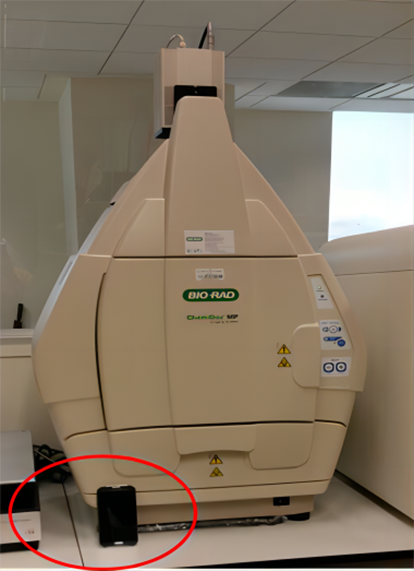In the context of biological experiment teaching, the nucleic acid gel electrophoresis process serves as a prime example of how the original APD apps can substitute for laboratory instruments and equipment. Traditionally, this process involves using the Bio-rad GelDoc XR Biorad Gel Imaging System (as shown in Figure 1) to quickly position, focus, and capture sample images in real-time. However, with the introduction of the Gelapp (depicted in the lower left corner of Figure 1), teachers and students are now able to accomplish image acquisition tasks without the need for traditional experimental equipment.

Figure 1: APD GelApp can partially perform the role of a Gel Imaging System

3D printed Bacteriophages

DNAapp, an app developed by Samuel Gans APD Lab in 2014

Output of GelApp, the gel electrophoresis app developed by Samuel Gan’s APD Lab in 2015.

StanXY app, developed by Samuel Gan’s APD Lab in 2016

APD Colony Counter App, developed by Samuel Gan’s APD Lab in 2017

DNA2app, the sequence analysis app by Samuel Gan’s APD Lab in 2017

APD SpectBT app, developed in 2020 by Samuel Gan’s APD Lab
Through the project, the original APD apps would be updated to integrate computer vision and machine learning, with relevant teaching methods to establish a "mobile digital biology laboratory." These applications aim to overcome the challenges in experimental teaching caused by pandemic prevention policies or lack of specialized equipment. Additionally, upgraded APD apps will be used to develop a new general biology experiment course trials, addressing the issue of insufficient lab time for students. SCI international journal paper will be published to discuss the impact of this application on teaching reforms.
Key innovations include:
Addressing the reduced frequency of student experimental operations due to COVID-19 and other unforeseeable factors, the team developed APD apps. This allows students to perform experiments anytime and anywhere using their smartphones, eliminating the need for traditional lab settings.
The project focuses on the practical issues encountered in lab classes, such as equipment failure or scarcity, using the upgraded APD apps to enhance the teaching content and transform the classroom teaching model. This development aims to improve students' professional knowledge and practical lab skills.
The project's success in incorporating foreign online experimental courses, textbooks, and applications into the school's curriculum offers a model that can be replicated and extended to other professional experimental courses, facilitating digital education reform across multiple disciplines.
The following achievements have been made :
- Zealyn, Darius, Joshua, Ooi, Samuel,2022, “Effects of different delivery modes on teaching biomedical science practical skills in higher education during the 2021 pandemic measures”, https://iubmb.onlinelibrary.wiley.com/doi/10.1002/bmb.21637
- “Experimental Biomedical Laboratory Skills (BME261)”, 2021, https://www.suss.edu.sg/courses/detail/bme261
- “Advanced Experimental Biomedical Laboratory Proficiency (BME361)”, 2021, https://www.suss.edu.sg/courses/detail/bme361
- Wei-Ling, Ian, Chun-Foong, Samuel, 2019, “A Review of Apps for Programming: programming languages and making apps with apps”, https://www.scienceopen.com/hosted-document?doi=10.30943/2019/25012019
- Samuel Gan & Jun-Jie Poh, 2020, “Basic Practical Molecular Biology”, https://www.amazon.com/Practical-Molecular-Biology-Samuel-Ken-En-ebook/dp/B08CDLK62F
The following application results have been achieved:
- APD Colony Counter App Pro. DOI 10.1186/2019/c23122019
- GelApp. DOI 10.1186/2019/23122019
- APD SpectBT. DOI 10.1186/2019/s23122019
- APD ECG-BT. DOI 10.30943/2019/s23122019
- APD Foot Alarm. https://apptopia.com/google-play/app/apd.bii.footalarm/about
- APD Reference App. DOI 10.30943/2020/19022020
- APD Volumetric App. DOI 10.1186/s41070-017-0019-8
- APD Areametric App. DOI 10.30943/2019/08022019
- APD Wound Monitoring App. DOI 10.30943/2019/28052019
- APD Labyrinth. https://apptopia.com/unified/app/8137103561/intelligence
- APD MisDirection. https://apptopia.com/unified/app/8181054381/intelligence
- APD Recollection. https://apptopia.com/unified/app/8137103581/intelligence
- DNAApp. DOI 10.1093/bioinformatics/btu525
- DNA2App. DOI 10.1186/s41070-016-0004-7
- StanXY. DOI 10.1186/s41070-015-0003-0
PROJECT TEAM MEMBERS: AKUETTEH PERCY DAVID PAPA, ALOYSIUS WONG TZE HERN (THE "APD BIOLOGY EXPERIMENT APPLICATION" DEVELOPED IN THIS PROJECT WILL BE APPLIED TO THEIR CLASSROOM TEACHING.)



